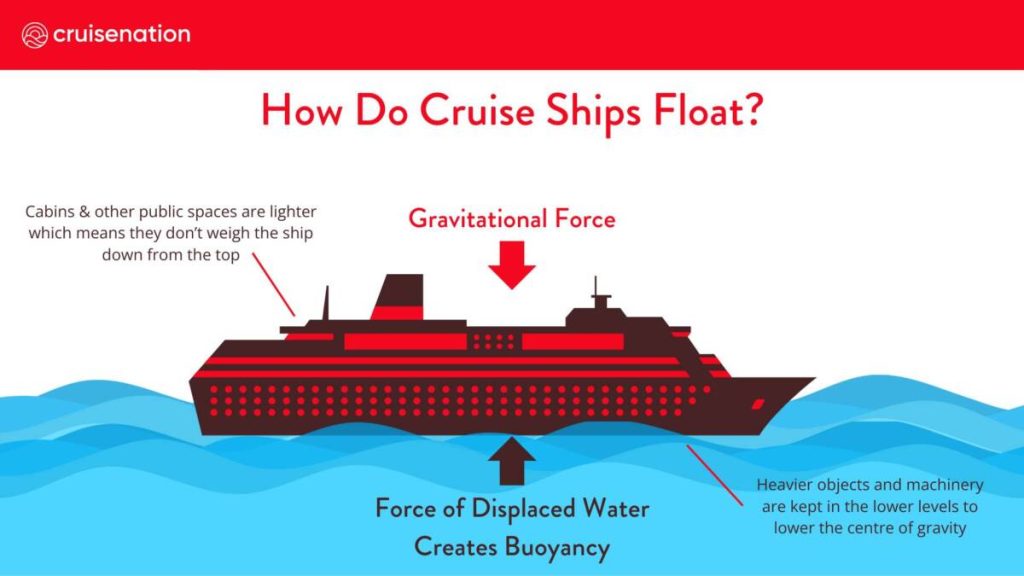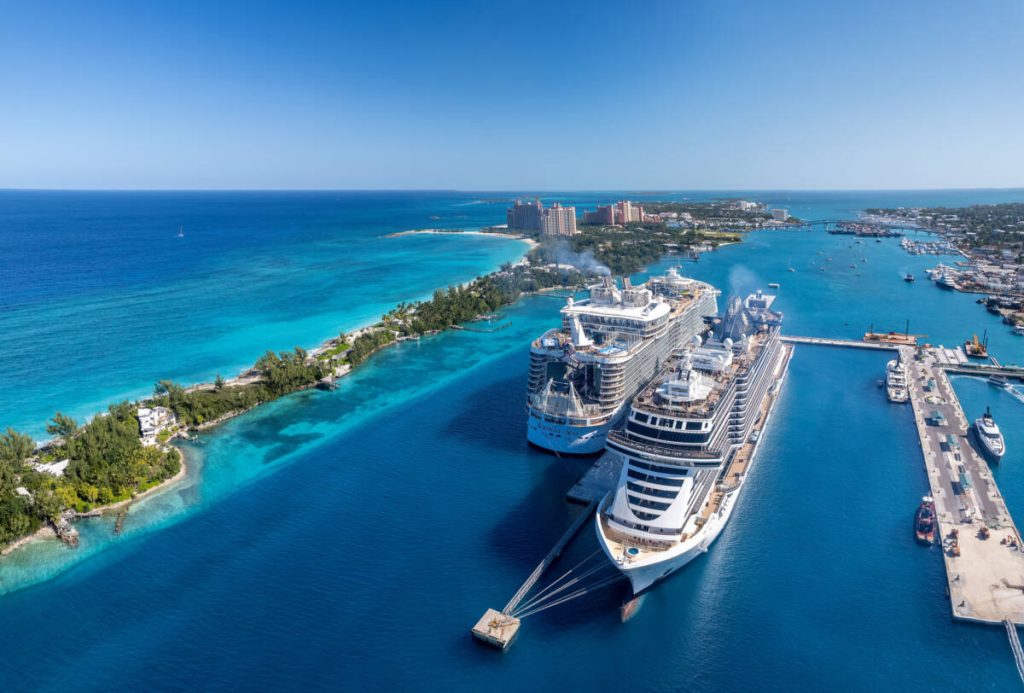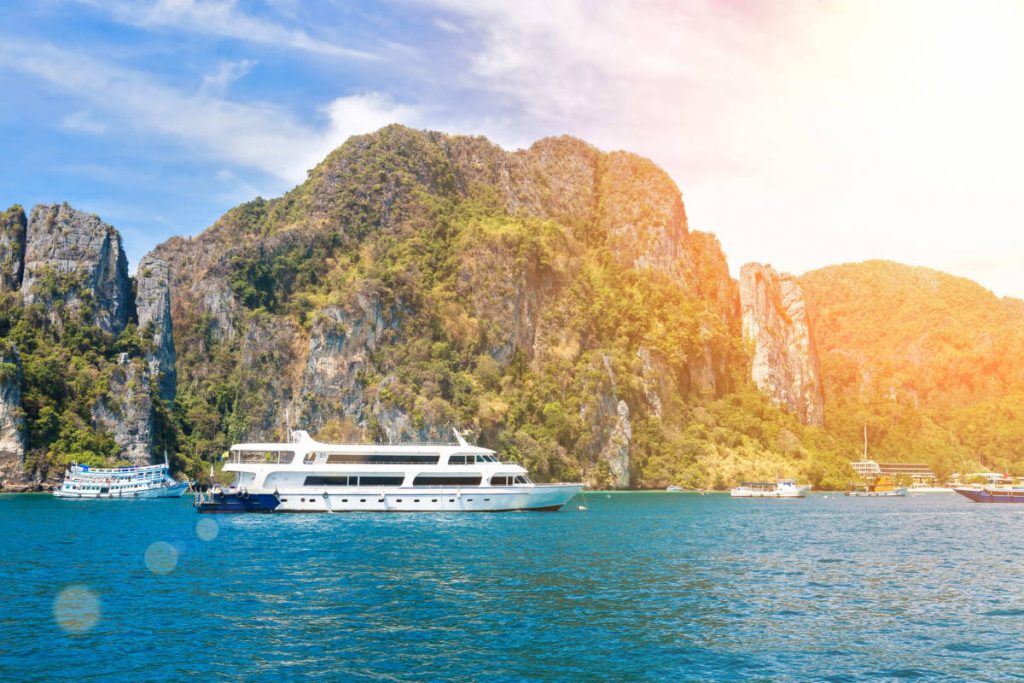Have you ever wondered how cruise ships can float so effortlessly on the water despite their huge size and stature? With a combination of simple scientific theory and clever design techniques, cruise lines around the world have perfected their ability to launch ships of all sizes that can float and sail across seas, oceans and even rivers.
When you really think about it, though, it can seem unfathomable that ships as massive as the Royal Caribbean’s Icon of the Seas, weighing over a quarter of a million tonnes and taking the crown as the largest cruise ship in the world, can navigate through waterways without any problems. So how do they make it possible?
It’s no surprise that many people are left in awe of these feats of engineering. If you’ve ever wondered how cruise ships can offer amazing activities like rock climbing and ice skating, along with other amazing facilities, we’ve got you covered with our informative guide explaining everything from ship hulls to buoyancy. Whether you’re curious about how these massive ships stay afloat or any other aspect of their operations, our guide is here to help you out.
How do Cruise Ships Float? Buoyancy Explained

The reason that large cruise ships carrying hundreds of thousands of tonnes can float on water is largely down to physics. Put simply, cruise ships float because their mass is low in relation to the volume of water they’re sailing on. This creates an effect called buoyancy, which keeps the ship upright and afloat.
Cruise ships must be able to withstand the weight of the ship, the crew, luggage, supplies and passengers. This mass can total anywhere upwards of 65,000 tonnes. While this might seem like a lot, it’s nothing compared to the mass of water in the world. Cruise ships can displace the equivalent amount of water to their mass when they put pressure on the ocean, which pushes the ship upwards.
To keep afloat, the cruise ship must be able to displace its weight in water before being submerged. That’s a lot easier to do if the cruise ship is constructed in a way so that it’s less dense than the water below it. So how do cruise ship engineers achieve buoyancy during construction? The solution is simple – they choose lightweight, sturdy materials and disperse the weight of the ship across the hull, which we’ll explain in more detail later.
The History of Archimedes Principle
Archimedes is to thank for our understanding of buoyancy. Archimedes’ Principle states that any object totally or partially immersed in a fluid or liquid is buoyed up by a force equal to the weight of the fluid displaced by the object. So how did he find this out?
Archimedes came up with a unique idea to measure the volume of his body accurately against a body of water. As he sank into the water, it rose up and became displaced. From this experiment, he realised that if he could measure the amount of displaced water, he would be able to measure the volume of his body. The story goes that he also used this principle to find out if a goldsmith was cutting his gold with a less-dense metal like silver, but today his principle can be used to understand buoyancy.

For any object to float, the downward force of the object on the water should be less than the upward force of the water pushing back against the object. According to NASA, Archimedes’ principle states that the buoyant force, which is the difference in the upward and downward forces on an object in water, is equal to the weight of the water that the object displaces.
The easiest way to understand how it works is to imagine a toy boat in a bucket or bath filled with water. The volume of water being displaced by the object is tiny in comparison to the mass of water in the container, which allows it to float. Cruise ships work using this physics-based theory – only on a much larger scale.
Does this Work for Huge Cruise Ships?
Theoretically and practically, Archimedes’ Principle applies to huge cruise ships. While it’s true that the bigger the cruise ship, the more design and build considerations are needed to check that it will be buoyant when launched into the sea. But with the incredible engineers and technology available from shipbuilders, it isn’t a difficult task for them to create huge cruise ships with multiple restaurants, hundreds of staterooms, onboard theme parks, giant swimming pools and anything else they can think of.
How Much Water does a Cruise Ship need to Float?
Essentially, cruise ships can stay above the water as long as they can displace an equal amount of water to their mass. This means that most cruise ships are best suited to sailing around seas and oceans where there is more than enough water. Obviously, a cruise ship wouldn’t be able to sail on a small body of water that wouldn’t be able to displace the weight of a ship, which is why you won’t see any floating on smaller lakes.
This is why smaller cruise lines such as Fred. Olsen are perfect for meandering along rivers and reaching narrow port openings, while larger ships like much of Royal Caribbean’s fleet are best suited for transatlantic sailings. Their size is much more relative to the body of water they’re floating on, which means they can be propelled upwards and remain steady as they sail.

Does the Design of a Cruise Ship Help?
Engineers and shipbuilders use their incredible knowledge of cruise ship design to make sure the ship can float and glide through the water with ease while also providing passengers with wonderful onboard experiences. So which design features do they pay the closest attention to?
The Ship’s Hull
The hull of a ship is not only important for stability, but it also provides protection for the entire ship. Fibreglass, composite materials, and even steel can be torn apart by reefs, sandbars, and icebergs as we all famously know from the Titanic. To prevent such catastrophic damage, shipbuilders make use of super-strength steel and insert double hulls (a hull inside a hull, technically speaking). This way, the hull can offer even more protection and give everybody peace of mind that the ship can remain stable and secure no matter what happens. Passengers on ships with these hull types rarely feel any rocking or side-to-side movement.
Shipbuilders will often construct a round-bottom displacement hull which has rounded edges to minimise the force of the water against the hull. This allows larger and heavier ships to sail smoothly. Unlike other hull types such as the v-hull which rises out of the water and skirts the waves, round-bottom hulls push through the water, making them extremely stable and seaworthy.
Bulkheads
On the rare occasion that an unforeseen accident does happen, vertical watertight dividers called bulkheads are installed throughout the interior of the hull. These dividers keep damaged ships afloat by containing incoming water in one or two compartments, which means the cruise ship can continue its voyage without flooding and also with little to no effect on crew and passengers.
Ship Layout Design
The ship layout can also have a big impact on the centre of gravity, water displacement and mass. This is why you’ll find that cruise ships are designed to be bottom-heavy since this keeps the centre of gravity low and allows just enough of the ship to sit underwater and displace its mass accordingly through the seas and oceans. Storage facilities, water tanks, engine rooms and anything else requiring heavy materials will always sit on the lowest decks of a cruise ship, and these are often inaccessible to passengers because of health and safety.
Anything else – including staterooms, pools, restaurants, entertainment facilities and more – will be found on the higher decks of the ship. These are built with lightweight materials which helps with the ship’s centre of gravity. Plus, it means that the facilities are quicker and easier for passengers to access since they’re all on relatively similar decks, making it a win-win situation.
So there you have it – we hope you enjoyed our guide explaining the ins and outs of how cruise ships float. And if all this talk of cruise ships has left you yearning for a holiday at sea, be sure to check out our cruise deals.

